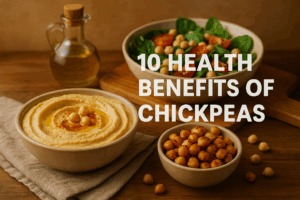Small but Mighty: The Lasting Energy and Holistic Benefits of Chickpeas

I still recall my first encounter with hummus on a sunlit patio in the Mediterranean. A dollop of creamy chickpea spread perched on warm pita felt indulgent yet surprisingly light. That simple bite sparked my curiosity: how could a single legume offer such satisfaction and, as I would later discover, so many health advantages?
Chickpeas, or garbanzo beans, have been a dietary staple for millennia—from Middle Eastern mezzes to Indian dals and Mexican stews. Today, they stand at the forefront of plant-based nutrition, celebrated for their rich blend of protein, fiber, vitamins, and minerals. Whether you’re vegan, diabetic, an athlete, or simply health-conscious, chickpeas can fortify your diet with lasting energy, balanced blood sugar, and inner resilience. Let’s explore ten compelling reasons to make chickpeas a daily habit, plus practical tips to incorporate them—and precautions to keep in mind.
1. Complete Plant Protein for Muscle Health
Chickpeas provide about 19 grams of protein per cooked cup (approximately 164g). Unlike many plant foods, they contain a broad spectrum of essential amino acids, making them a near-“complete” plant protein.
Muscle repair & recovery: Post-workout, your muscles crave amino acids to rebuild microtears. Chickpeas offer a steady supply without the saturated fat found in some animal proteins.
Vegan-friendly gains: For vegetarians and vegans, chickpeas power up smoothies, shakes, and grain bowls with robust protein that supports both strength training and everyday activity.
2. High Satiety from Soluble & Insoluble Fiber
With 12.5 grams of fiber per cup, chickpeas slow digestion and extend feelings of fullness. They contain both:
Soluble fiber, which forms a gel in the gut, moderating blood sugar and lipid absorption.
Insoluble fiber, which adds bulk to stool, promoting regular bowel movements.
This dual action not only prevents overeating but also stabilizes energy levels, making chickpeas invaluable for weight management.
3. Steady Blood Sugar Control & Diabetes Prevention
Thanks to their low glycemic index, chickpeas release carbohydrates slowly, blunting post-meal blood sugar spikes. Studies show that diets rich in legumes like chickpeas can:
Improve insulin sensitivity, reducing the risk of type 2 diabetes.
Lower hemoglobin A1c levels, a key marker of long-term blood sugar control.
For those monitoring glucose, swapping out high-GI carbs for chickpeas can be a strategic move.
4. Iron & Folate for Strong Blood & Vitality
Each cup of chickpeas delivers more than 4 mg of iron (about 22% of daily needs) and about 70 mcg of folate (nearly 18% of daily requirement). Together, these nutrients:
Support red blood cell production, preventing anemia and its associated fatigue.
Aid energy metabolism, fueling every cell in your body.
Pregnant women, adolescent girls, and vegetarians often benefit most from this duo, maintaining steady oxygen delivery and vibrant energy throughout the day.
5. Heart-Healthy Fats, Cholesterol Reduction & Blood Pressure Balance
Chickpeas contain unsaturated fats, magnesium, and potassium, which help:
Lower LDL (“bad”) cholesterol, by up to 8–15% according to some clinical trials.
Promote arterial flexibility and healthy blood pressure, reducing cardiovascular disease risk.
Regular legume intake correlates with a 20–30% lower risk of heart disease, making chickpeas a smart component of any heart-healthy lifestyle.
6. Bone & Joint Support via Key Minerals
With manganese, calcium, and phosphorus, chickpeas contribute to:
Bone mineral density, helping ward off osteoporosis.
Joint comfort, as manganese participates in cartilage synthesis.
For older adults or anyone seeking lifelong skeletal health, these minerals—coupled with the anti-inflammatory benefits below—make chickpeas an invaluable food.
7. Gut Microbiome Nourishment & Digestive Comfort
Chickpeas’ fermentable fibers act as prebiotics, feeding beneficial bacteria like Bifidobacteria and Lactobacilli. A balanced microbiome supports:
Efficient nutrient extraction and vitamin synthesis.
Reduced gut permeability, lowering systemic inflammation.
Start each morning with a spoonful of cooled chickpea soup or oatmeal topped with chickpeas to promote daily digestive wellness.
8. Potent Antioxidants & Anti-Inflammatory Phytochemicals
Beyond fiber and protein, chickpeas contain polyphenols and flavonoids that:
Mop up free radicals, protecting DNA and cell membranes.
Downregulate inflammatory pathways, alleviating aches, joint discomfort, and chronic disease progression.
Incorporate spiced roasted chickpeas or chickpea curries to maximize these protective compounds.
9. Sustainable, Eco-Friendly Protein Source
Chickpeas are climate-friendly legumes that:
Fix nitrogen in soil, reducing the need for synthetic fertilizers.
Thrive in low-water conditions, making them a sustainable choice versus resource-intensive animal proteins.
Eating chickpeas isn’t just health-smart—it’s a vote for planetary wellness and biodiversity.
10. Mood & Cognitive Support via Tryptophan & B Vitamins
Chickpeas supply tryptophan, the precursor to serotonin, alongside B vitamins that underpin neurotransmitter production. This combination can help:
Stabilize mood and reduce anxiety.
Enhance sleep quality, since serotonin converts to melatonin at night.
If you struggle with stress or sleep, adding chickpeas to evening meals may promote a calmer mindset and more restful slumber.
Practical Ways to Enjoy Chickpeas Every Day
Classic Hummus Makeover
Blend cooked chickpeas with extra-virgin olive oil, tahini, lemon, and garlic for a nutrient-dense dip.
Serve with raw veggies, whole-grain pita, or dolloped atop grain bowls.
Vibrant Chickpea Salad
Toss chilled chickpeas with cucumber, cherry tomatoes, red onion, fresh parsley, lemon juice, and olive oil.
Add crumbled feta or avocado for extra creaminess and richness.
Hearty Chickpea Stew or Curry
Simmer chickpeas in fragrant spices—cumin, coriander, turmeric—and coconut milk for a comforting, protein-packed main course.
Pair with brown rice or cauliflower rice for a balanced plate.
Crispy Roasted Chickpea Snacks
Season drained chickpeas with smoked paprika, garlic powder, and sea salt; roast at 200°C (400°F) for 25–30 minutes until crunchy.
Perfect for on-the-go snacking or as a salad topping.
Chickpea “Rice” or Pasta
Use chickpea flour or canned chickpeas in pasta or flatbread batter.
Explore chickpea-based pasta for a gluten-free, high-protein alternative.
Precautions & Personalized Tips
Start Slow: Novel legumes can cause gas. Begin with ¼–½ cup servings and gradually increase.
Soak & Rinse: Soaking dried chickpeas 8–12 hours and discarding soak water reduces oligosaccharides that cause bloating.
Cooking Methods: Pressure-cook or simmer until tender for optimal digestibility.
Tailor to Your Constitution: If you have a “cold” digestive type, enjoy chickpeas in warm soups and stews. If you’re prone to sluggishness, combine with warming spices like ginger or cumin.
Allergy Alert: Though rare, legume allergies exist. Test a small amount first and consult an allergist if you experience adverse reactions.
Final Encouragement: A Simple Bean, Transformative Impact
Chickpeas are more than pantry staples—they’re seeds of sustainable energy, nutritional abundance, and culinary creativity. By weaving them into daily meals, you nurture muscle, heart, gut, mind, and planet alike. So tomorrow morning, fill your spoon with hummus and dig into a chickpea salad—your body and the earth will thank you.
